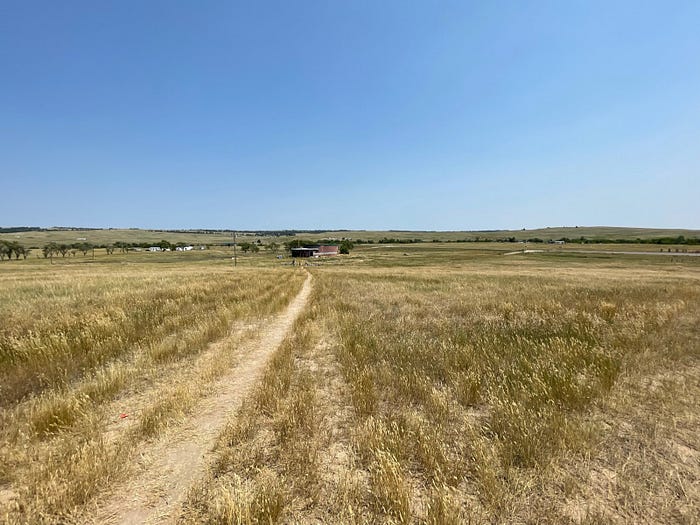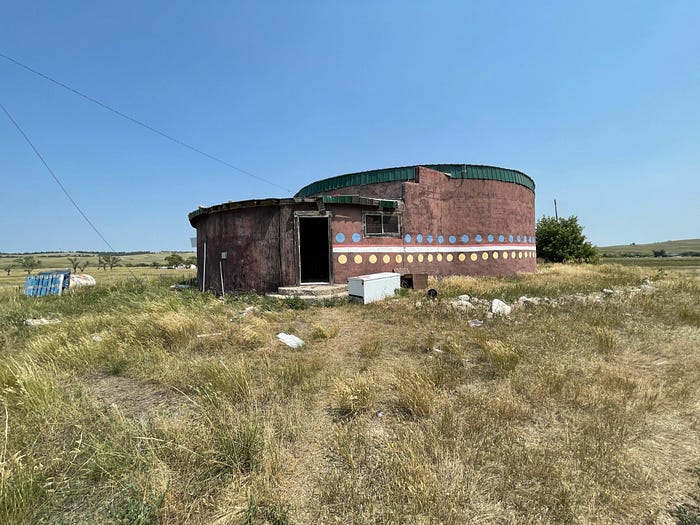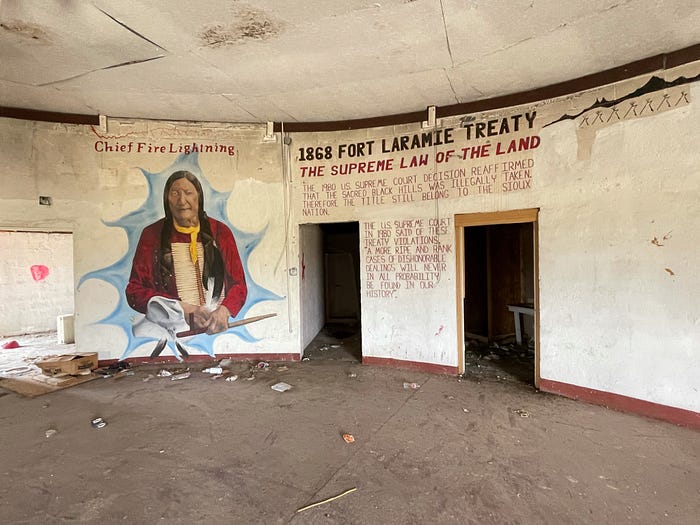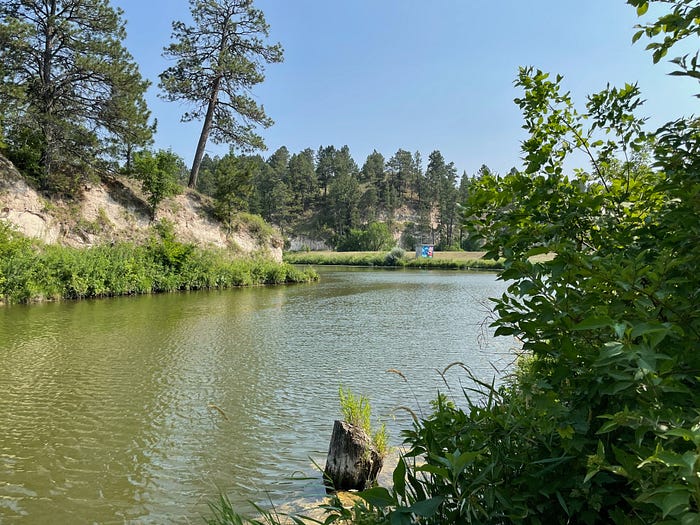An Outsider’s View of the Pine Ridge Indian Reservation

I’ve been procrastinating on this entry, because I don’t feel fully qualified to write it. We spent only about a week on Pine Ridge. Most of our time was spent on a 10-acre pastured poultry farm run by our friend AJ (Check out homegrownporkandpoultry.com, where you can donate high-quality protein to Pine Ridge families.) In some ways his home is an island on the reservation, so to write about Pine Ridge as though I acquired some deep knowledge of the place feels disingenuous. On the other hand, not writing about it would deny the real impact it had on my worldview. Not to mention that places like Pine Ridge are very much, “out-of-sight, out-of-mind” for the vast majority of Americans, myself included, so perhaps my small insights are better than nothing.
For those who are totally unacquainted: Pine Ridge is a Lakota Indian Reservation in South Dakota, primarily inhabited by the Oglala band. It is considered to be one of the poorest places in North America. The people reside in an area the size of Connecticut, with only two grocery stores on opposite ends. Services are virtually non-existent, including the things that we more fortunate Americans regard as unwelcome intrusions, like the DMV. Male life expectancy is 47 years old. The infant mortality rate is five times higher than the national average. Adolescent suicide is four times higher. Unemployment is 87%. Alcoholism and gang-culture run rampant. It isn’t fair for these to be the primary ways to describe a multi-faceted place, but how else do you convey the reality its inhabitants face?
That’s the facts-and-statistics description of Pine Ridge. For what it’s worth, my own description: Pine Ridge is a place mired in generational trauma. It is a place that will defy any reductionism, or simple-minded partisan prescriptions. In many ways the people have been enslaved and shattered by a welfare-state imposed on them against their will. Poverty there is simultaneously habitual, and seemingly inescapable. Someone we met there described it as a POW camp, but the guards have simply walked away. For all that, there is good in the place. Decent people trying their best to make ends meet, and improve their community.
For a few weeks now I’ve been wrestling with how to frame this article. At first I felt that I should do more research on Pine Ridge and Indian culture; partially to avoid misrepresentations, but also so that I could inject depth into the piece. I wondered if I should call AJ for more information and fact-checking. For a variety of reasons, I decided just now to jump into the deep-end of sharing my thoughts before I actually feel prepared to do so.
For one thing, the perspectives you can gain from reading are invaluable. However, I couldn’t shake the feeling that I was trying to manufacture authenticity. This was an experience that I went into completely blind — writing an article dressed up with perfect hindsight and researched opinions is almost a form of dishonesty. The other aspect that troubles me is that real human beings rarely conform to the high-minded narratives of academia. And that’s not a slight on any of the books of I’ve been reading, or attempts to intellectualize culture and humanity. What I mean is that the majority of people live in the here-and-the-now.
Most people are primarily aware of the realities that they have been born into, underlaid by a smattering of the folklore-history traditions of their culture. I’m making this statement about all human beings. Let’s be honest, how often does the average American deeply research and ponder our own history? We are all taught the cartoonish version of Christopher Columbus sailing his three ships across the ocean. The majority of people know George Washington as, “that guy who lead the Revolution, and chopped down a cherry tree.” Cowboys wandered the prairie fighting Indians and hunting outlaws, for some reason. My point is that reading history books rarely tells you much about the cultural zeitgeist of the present day. Everything I have read so far about the Oglala Sioux has been illuminating — but to the average human being, living on Pine Ridge, looking for work and gas money…it might be missing the forest for the trees.
To counter my own point, the Oglala Sioux undoubtedly are far more engaged in their history than the average American. Their history is alive and recent to them, for good reason. They live in a reality dictated by tragedies that occurred before they were born, and led directly to the injustices they experience now. The trouble is, I’m not the guy to tell you that history, because its impossible for me to understand the intricacies of how the written narrative interplays with the oral narrative of these communities, and equally difficult to determine which is more important. The truth can be a lot more complicated than the facts.
An example: were cowboys rugged individualists, chasing justice and freedom on the open prairie? Or were they simply 18th century long-haul truckers, beholden to massive landholders and the legalities of grazing rights? Is their cultural niche a fabrication of dime-novelists, or a just portrayal of the living legends of the time? I’m a history junkie, and I can read about it all I want, but in the end, the cultural definition of the cowboy is always going to transcend the reality. This same principle is part of what makes it difficult for me to write about the Oglala Sioux.
Americans, Native-Americans…We all have an image of who Native people are, including those Native people themselves. Were the Sioux a belligerent, war-like people pushed to the fringes by encroaching civilization? Outraged environmentalists resisting the wanton destruction of whites? Disorganized, tribalistic nomads, or free-spirited survivors bound by honor to their communities? From all that I can gather, all of these things may be true.
It’s too simplistic in my view to portray the history of the Sioux solely as a victimized people. To paint them as the noble-savage, free from vice and sin is to steal their humanity from them as surely as anything else. Too often, I think the popular myth is of a culture defined by harmony with nature. This may be a piece of the truth, yes, but they are also warriors, leaders, politicians and above all else human — capable of the same goods and evils as anyone else.
That’s a lot of bloviating on my part, but I feel it’s an important prelude to my understanding of Pine Ridge. The people there live in the of shadow of history. It’s a place of immense tragedy and corruption, but there are seeds of hope. From this point on, I’ll return to my usual habit of reporting events as they occurred, and what I thought at the time. Hopefully this write-up will provide some sort of meaningful impression to someone not acquainted with the Pine Ridge Reservation.
We started our tour at the Wounded Knee Massacre Site. It is a stark, sad, place. Rarely is it a part of the American psyche to approach a monument with shame. Sadder still is the site’s neglect. The building that once served as a visitor center is burned out and filled with garbage. The only real markers are the sign explaining what happened, and the graveyard at the top of the hill. We spent time at both. The graveyard is still active — people have been buried there recently. We wanted to see what was left of the visitor center, so we walked down the hill and went inside.



The best word for it is apocalyptic. The feeling inside that visitor center hammered home that what happened to these people was in essence, an apocalypse. They were facing an enemy of endless number, armed with impossible weapons, so bent on the destruction of the Indian culture that they were willing to exterminate the bison, merely to starve them into compliance.

The pictures below are all from the interior of the visitor center. I’ve transcribed them for ease of reading. To be clear: the incidents described below are not the wounded knee massacre, which took place in 1890, and claimed the lives of 146 Lakota men, women, and children.

During the 1970’s terror once again filled the Pine Ridge Indian Reservation, The traditional LAKOTA were being terrorized and murdered. The Corrupt Tribal Chairman and his Goons, along with the FBI carried out the reign of terror. The Chiefs and Headsmen had meetings and called AIM to come and assist. On February 27, 1973 the siege began here and the war was on for 71 days. Two LAKOTAS were killed in action, Buddy Lamont and Frank Clearwater who gave the ultimate sacrifice. LAKOTA War leader Pedro Bissonette was gunned down by the BIA police 6 months after the Takeover. The American Indian movement was instrumental in a lot of the positive changes that affect us today. Indian Pride was revived and resurgence of our Spirituality Began.
This display is referring to a conflict over the legitimacy of the elected Tribal Government. The Indian Reorganization Act of the 1930s allowed tribes to form their own democratic constitutions (still with oversight by the Federal Bureau of Indian Affairs). The new governmental system was in tension with traditional, hereditary clan structures, and corruption was rampant in the new system. The display referring to the Tribal Chairman’s “Goons” isn’t editorialized. They literally operated under the acronym, Guardians Of the Oglala Nation.
Lakota protesters occupied the town of Wounded Knee, demanding that the corrupt Tribal Chairman be removed. US law enforcement was brought in to assist the elected chairman, including the FBI, Marshall Service, and DOJ. The standoff ended in gunfire and casualties on both sides. In light of the violence, Lakota Elders asked for the protests to end. The US government stated that it could not remove the chairman, as the Lakota have “sovereignty.”
The facade of “sovereignty” that Pine Ridge operates under is, in my opinion, a cruel joke. It is the perfect cop-out. Confine a people to a wasteland, destroy their culture by force, and supply essentially no services or restitution. And if anyone complains or speaks out, you can say, “What do you mean? You are sovereign! This is your problem.” I’m not saying that I have an alternative solution. What could even be done? Seize the remainder of Pine Ridge, and co-opt it into South Dakota? I’m sure that would go over well. The more you learn about Pine Ridge, the more you realize that there is no silver-bullet to put things right.

1868 Fort Laramie Treaty
The Supreme Law of the Land
In 1980 US Supreme Court decision reaffirmed that the Sacred Black Hills was illegally taken. Therefore the title still belong to the Sioux Nation. The US Supreme Court in 1980 said of these treaty violations, “A more ripe and rank cases of dishonorable dealings will never in all probability be found in our history.”
In case you’re wondering, the Supreme Court subsequently ordered “just payment” for the Black Hills to be issued to the tribe. The tribe did not accept the money, because it would end their legal claim to the Black Hills. If I could toss my two cents behind the Supreme Court statements — I strongly recommend just browsing the Wikipedia article about Pine Ridge. The land seizures, abuses, and “rank dealings” did not begin or end with the Black Hills. You owe it to yourself as a U.S. citizen to be aware of what crimes our government can perpetrate.

THE INDIAN WARS ARE NOT OVER
These are not the words you see in a museum in the United States. They could be written by an insurgency group. They are the words of an occupied nation. We left the place with an eerie feeling.
The next stop on our list was Yellow-Bear Canyon. We drove through several “towns” along the way. “Towns” in quotes, because most of the towns of Pine Ridge appear to have had housing simply fall out of the sky at quasi-random locations, with no regard for availability of goods and services. Another product of the U.S. Government “helping.” There are few non-residential buildings, aside from small schools and the rare gas station.

Hiking Yellow-Bear Canyon was a welcome reprieve from the depressing atmosphere of the Wounded Knee Memorial. The truth is that many places on the Res are actually quite beautiful. I can’t neglect to mention that. There are towering badlands formations, pine forests tucked into folds in the hills, and prairie grass undulating in the wind. I truly hope that one day the landscape of Pine Ridge gets it’s due.
When we returned to our car, there was a Native father swimming in the reservoir with his three young children. The kids splashed and squealed, and occasionally cried. The father responded like any good dad — brief comforting words, followed by tossing the whiny child into the water, quickly converting the tears into laughter. It was a small beach, and he probably realized that we felt out of place. He called out a greeting and an invitation to swim.
We didn’t swim, but the scene of normalcy was comforting. There are so many people on Pine Ridge that really are doing their best. We have all known people in our personal lives who fall in with “the wrong crowd,” and their lives go off-track. Whether its drugs, alcohol, cheating on unemployment, familial abuse… These things have gravitational pull. We are made by our environment and the people we spend time with. I cannot imagine the depth of resolve required to remain positive and productive on Pine Ridge, where these issues are ubiquitous.
Another farmer we visited on the neighboring Rosebud reservation told us a story that illustrated just how hard it could be. He knew a young kid who joined the military to get his act together, and came back to the reservation flush with savings and new ideas to reinvest in his community. It wasn’t to be. His old “friends” felt that he was being stingy with those savings, and shot him dead for gas money. Human beings can have a terrible similarity to crabs trapped in a bucket. When one breaks the trend and tries to crawl out, the others will pull it back down.
Our next stop was another flash of hope. We drove through the town of Kyle and saw a sign for the “Waste Wota Diner.” We stopped in and ordered food. The front was unfinished, but the interior was beautiful! The owners renovated it to be very chic and modern by reservation standards (and nice by any standard). Our food was delicious too — it was classic roadside diner food, done very well. The owner came out of the kitchen to talk to us.

Her name is Destiny, and she is awesome. Her family opened the diner at the start of COVID, but they did well, offering takeout only. They just opened the dining room that month. She told us that she tries to hire as many young people as she can. In her words, “People say that Indians don’t want to work, and it’s true. I want young people to learn how.” Unemployment on the reservation is 87%, but everyone eating there looked like they were on lunch-break from their jobs. It was genuinely exciting to see that there were people coming in to spend cash on a decent lunch. If there is any “silver-bullet” to Pine Ridge’s issues, it will come from within. Someone like Destiny and her family can be the pebble that starts an avalanche. I truly wish her luck.
I started this entry without any sort of guiding thesis. How can you distill such a complicated place into a few statements? The problems Pine Ridge faces are intertwined like a Gordian knot. If anyone has a shot at untying that knot, it’s the people who live there and experience these issues first hand. The heartbreaking thing is that they are handcuffed by circumstance to the auspices of the U.S. government. They have almost third-world infrastructure, but are trapped by the requirements of a first-world country. Being a developing nation is hard enough — imagine being a developing nation that still has to get to the DMV, pass health inspector tests, and get business licensure from uncooperative, possibly corrupt bureaucrats.
I admit, I’m extrapolating here. I don’t actually know how hard it is to achieve these things on Pine Ridge. But I do know that as a relatively fortunate person in New York, red-tape and paperwork can suck half of your life away in the blink of an eye, and that’s with cooperative Farm Service agents and a DMV that’s open 5 days a week. I don’t even know where you would start on Pine Ridge. Someone who lives there might know, I hope. I do believe that the solutions will start from within. However, I do not see how the fundamental nature of the place can fully transform until their sovereignty is expanded to be meaningful. That, or abolished completely so that they can function as full citizens (and yes, I am aware of the massive problems of even suggesting that).

If you walk away from this article with anything, let it be this: Pine Ridge will not conform to typical partisan world-views. Anyone with a degree of intellectual honesty can see that. For all the troubles it has, I saw real glimmers of hope during my stay there, and if that spirit prevails, it could be a very different place in fifty years. The real question is, in a world where we tear at each other’s throats over gender-neutral bathrooms, and scream and cry over football players refusing to stand for the flag… why do we never hear about these third-world counties within our borders? Where is the national discussion on a place trapped in poverty, and governed at the highest level by non-elected bureaucrats in the BIA and FBI? It’s a colony of the sort that America has professed to abhor since its founding. That deserves at least a moment of our attention.
Hey, thanks for reading! If you enjoyed this article, you may enjoy my other article detailing the time that our van broke down, and we were forced to spend the night in the middle of Pine Ridge. It was… pretty crazy.
PS: Did you enjoy this article? Writing is a skill that you can apply anytime, anywhere in the digital world. Practice makes perfect. If you want to develop your abilities, you may want to consider my Writing Partner Program. Most creative writing programs force you to sit through several classes in person, waiting for your turn to share a single piece of your work and receive critiques. My Writing Partner Program gives you the opportunity to share your writing directly with me, and receive personalized advice, comments, and constructive criticism. Spots are limited, as I will be spending time exclusively focused on your work. Click the link to find out more!
